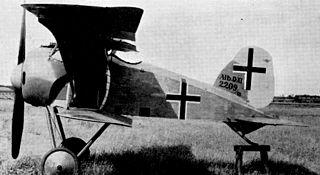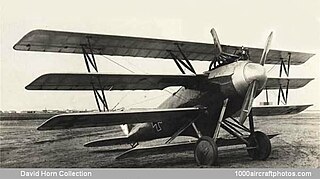| D.VI | |
|---|---|
 | |
| Role | Single seat fighter aircraft |
| National origin | Germany |
| Manufacturer | Pfalz Flugzeugwerke |
| First flight | Early 1917 |
The Pfalz D.VI was a German sesquiplane fighter aircraft from World War I. It was not put into production.
| D.VI | |
|---|---|
 | |
| Role | Single seat fighter aircraft |
| National origin | Germany |
| Manufacturer | Pfalz Flugzeugwerke |
| First flight | Early 1917 |
The Pfalz D.VI was a German sesquiplane fighter aircraft from World War I. It was not put into production.
The D.VI was a single bay sesquiplane with parallel chord wings which had angled tips The lower planes were smaller in span and chord than the upper ones but there was no stagger. The interplane struts were similar to those of the D.III, almost V-form but with a squared-off vertex and placed near the lower leading edge. The fuselage and wing centre section were joined by a pair of outward leaning cabane struts on each side. As on the D.III, the lower wing roots were carefully faired into the fuselage. There were ailerons only on the upper wings. [1]
The Pfalz was fitted with a nine-cylinder 82 kW (110 hp) Oberursel U.II rotary engine, driving a two-blade propeller with a large spinner. The fuselage was nearly circular in cross section; smoothly covered with plywood, it tapered towards the tail. The straight edged tailplane was mounted at mid fuselage and carried horn balanced elevators with angled tips. A nearly triangular, flat-topped fin carried a D-shaped rudder, hinged at the elevator trailing edge. A single-seat, open cockpit placed the pilot under the upper trailing edge, which had a shallow but broad cut-out to enhance his view. The D.VI had a simple fixed conventional undercarriage, with mainwheels on a single axle supported at each end by a slender V-form pair of struts. There was a small tailskid. It was armed with a pair of fixed LMG 08/15 7.9 mm (0.31 in) calibre machine guns, the standard German single-seat fighter equipment of the time. [1]
The D.VI was one of three Pfalz aircraft which competed at the first D-Type contest held at Adlershof in January and February 1918, the others being the D.VII and the D.VIII. It gained its Type Certificate in September 1918 but failed to win a production order. [1]
Data from Green & Swanborough [1]
General characteristics
Performance
Armament

The Albatros D.XI was a German single-seat fighter sesquiplane first flown in February 1918. It was the first Albatros fighter to use a rotary engine, in the form of the 120 kW (160 hp) Siemens-Halske Sh.III, and also featured a new wing construction with diagonal struts from the fuselage replacing traditional wire bracing.

The Nieuport Nie 31 or Nieuport 31 was a single-engine, single-seat monoplane or sesquiplane fighter aircraft designed and built in France in 1919.

The Siemens-Schuckert D.VI was a single engine, single seat, parasol wing German fighter aircraft flown in 1919.

The Siemens-Schuckert DDr.I was a World War I German twin engine, push-pull configuration triplane fighter aircraft. Only one was built, crashing on its first flight.
The Kondor E 3, sometimes erroneously known as E.III, was a German single seat, monoplane fighter aircraft designed and built close to the end of World War I. Though successful in the third D-type fighter competition at Aldershof in September 1918, only a few were produced, given the Idflieg designation of Kondor D.I.

The Kondor D 7 was a prototype German single seat biplane fighter built over the winter of 1917-18. It was not a success and its development was soon abandoned.

The Kondor D 6 was a prototype German biplane fighter aircraft flown in 1918. In the interests of better upward vision for the pilot, its upper wing was in two halves, separated over the central fuselage. Its development was soon abandoned.

The Naglo D.II was a German single seat quadruplane fighter, flown late in World War I. It took part in one of the fighter competitions but did not reach production.

The Pfalz D.XV was a German single seat fighter aircraft which was approved for production right at the end of World War I, too late to enter service.
The Pfalz D.VII was a German biplane fighter aircraft from World War I. It was not put into production.

The Hanriot H.26 was a French single seat fighter aircraft prototype completed in 1923. Only one was built.

The Luft-Fahrzeug-Gesellschaft (LFG) Roland D.VII was a German single seat, single engine biplane fighter aircraft built during World War I. Problems with its underdeveloped V-8 engine prevented its production.

The LFG Roland D.IX was a World War I German single seat fighter aircraft, a biplane powered by one of a new generation of powerful rotary engines. Three slightly different prototypes were built but there was no series production.

The LFG Roland D.XV was a World War I German single seat fighter aircraft, ordered as a test-bed for engine comparisons. It was distinguished from earlier Roland biplane designs by the elimination of flying wires. Two later aircraft, also called LFG Roland D.XV, were completely different designs with slab sided fuselages.

The LFG Roland D.XVI, initially designated the LFG Roland E.I, was a single-seat, single-engine, parasol wing German fighter aircraft flown close to the end of World War I. Only two were built.

The LFG Roland D.XVII was a single-seat, single-engine, parasol wing German fighter aircraft flown close to the end of World War I. Only one was built.
The Schütte-Lanz D.VI was a single engine, parasol wing fighter aircraft designed and built in Germany towards the end of World War I. It had a very short career, crashing on its first flight.
The Schütte-Lanz D.VII was a single engine, biplane fighter aircraft designed and built in Germany towards the end of World War I.

The Kondor D 2 was a German single seat, biplane fighter aircraft designed and built close to the end of World War I.

The Naglo D.I was a German single seat quadruplane fighter, flown late in World War I. It took part in one of the fighter competitions but did not reach production.